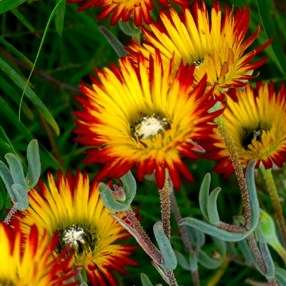



Drosanthemum micans - Robertson Vygie Seeds - Indigenous Succulents - Insured Flat Ship Rate
Check my rate
| Main centres: | 1-3 business days |
| Regional areas: | 3-4 business days |
| Remote areas: | 3-5 business days |




| Main centres: | 1-3 business days |
| Regional areas: | 3-4 business days |
| Remote areas: | 3-5 business days |

Drosanthemum micans Seeds
South African Indigenous Flowering Succulent

Mesembs is a common popular term used for succulent members of the family Aizoaceae, which are often placed in a separate family of their own, Mesembryanthemaceae. They are sometimes also referred to as vygies, fig-marigolds, ice plants, midday flowers, living stones or flowering stones. They display remarkable variation in leaf architecture, flower colour and form as well as fruit structure. Therefore these plants fascinate many plant lovers of all ages and have become popular amongst collectors of succulent plants. They make excellent potted plants. Drosanthemum is a genus of succulent plants in the ice plant family native to the winter-rainfall regions of southern Africa. Most species bear colourful flowers. The name Drosanthemum means Dew-flower in Greek, and refers to the characteristic shiny translucent papillae, which cover the succulent leaves and flower buds. There are over 110 species of Drosanthemum found in the arid areas of South Africa and neighbouring Namibia. The Drosanthemum genus is perhaps the most popular and spectacular of all garden mesembs. Few other plants can match the glowing intensity of a stand of these mesembs in full flower. Drosanthemum micans is a South African endemic species from the Western Cape Province where it can be found around Montagu and Worcester to Swellendam. It is a colourful spring flowering vygie that is a good choice for arid gardens across the country. Drosanthemum micans is a low-growing, dense, compact, perennial shrub that can attain a height of 60cm under ideal conditions. It has a fibrous root system and is shallow rooted. Like all drosanthemums, it is characterized by the dewdrop-like beads known as papillae found on the branches and flower stems. The leaves are opposite and nearly always equal. The flowers have red outer petals with chrome yellow inner petals. Flowers are borne in spring during the month of September. The seeds are very small, medium brown and round in shape. The seeds are dispersed by means of rainwater that open the valves located in the seed capsule. This splashing action disperses the seeds some distance away from the parent plant. In some cases rainwater will wash the seeds under other karroid plants in the area. As with many succulents, life begins under the protection of a nurse plant. A nurse plant is a shrub from where the young plant germinates and grows, protected by its leaves and branches from the sun's strong rays. With time they eventually outgrow their nurse.

